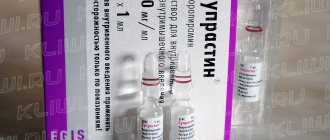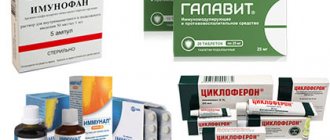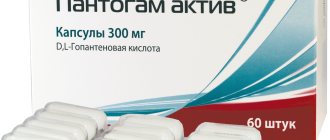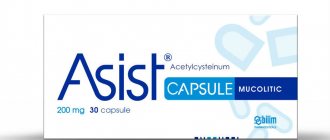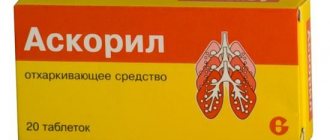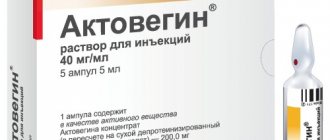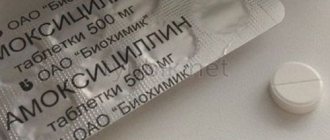When inflammatory processes occur in the body, it is necessary to use medications that fight such diseases. For Prednisolone injections, a wide range of medical indications are indicated, as well as side effects and dosage rules. The product is available in several forms, each of which is intended for a specific type of disease.
Mechanism of action
The antiallergic effect is manifested:
- suppression of the release of immediate allergy mediators;
- a decrease in the level of basophils, lymphocytes, eosinophils, monocytes and an increase in platelets, red blood cells;
- weakening of allergies by removing from a state of shock, improving the functioning of the central nervous system, cleansing the body of toxins, reducing the release of hormones;
- by decreasing the permeability of capillaries (small blood vessels), decreasing the number of basophils, this helps reduce itching and swelling present in all allergies;
- suppresses excessive manifestation of the immune system, which leads to the development of allergic reactions.
Use of Prednisolone - doses for children and adults
Many people wonder how to use prednisolone for allergies. There are 3 main principles when using medicine. Means:
- not used for prophylactic purposes;
- does not apply when there is an alternative option as another non-steroidal drug;
- used only in consultation with a specialist.
The medicine is produced as ointments, in tablet form, injections, and nasal drops. The purpose of any form varies depending on the type of pathological process, the complexity of its course and the age of the patient.
After long-term parenteral therapy, adhering to the principle of gradual withdrawal of steroid drugs, the patient can be transferred to oral treatment (use of tablets). Dosages of Prednisolone for allergies are selected by a specialist individually, taking into account age indicators and symptoms of the disease. The general regimen of using the drug lasts approximately 10-15 days.
Allergy tablets are taken orally without chewing:
- adults use 20-30 mg/day, with a transition to 5-10 mg.
- children use 1–2 mg/kg/day (for 5 doses).
When using the tablets, the following instructions must be observed:
- The product is swallowed whole, the tablets are not crushed. Drink a small amount of water.
- Reception is carried out directly in the morning. This is due to the fact that hormones of the adrenal cortex are naturally produced from 6 to 8 in the morning. Therefore, it is recommended to take the medicine during this period. When the daily dose is too large, it is divided into 2-3 doses.
- The drug is withdrawn over 3-5 days.
The tablet form is prescribed by specialists during an allergic reaction for a short course. If necessary, therapy can be continued in the future using antihistamines. Therapy is discontinued gradually. Injection solutions are administered:
- Adults - 1-3 ml is administered through a dropper; in difficult situations, the dose of prednisolone is increased to 300 mg.
- Children under one year old - 2-3 mg per kg of weight, from 1 year to 15 years - up to 2 mg per kg.
Secondary administration is permissible after 30 minutes. Allergy shots are not diluted with any injection solutions.
The ointment is applied to the damaged area in a small layer three times during the day. The drug course for acute allergic dermatosis lasts no more than 15 days. At the end of treatment, the frequency of application of the product should be reduced, this will reduce the risk of “withdrawal syndrome”.
It is advisable to prescribe the use of allergy ointment for a child over one year of age for a week. It is not recommended to use fixing bandages, as they increase the likelihood of the hormone entering the blood circulation.
Prednisolone should be used during pregnancy only when the expected effect for the woman outweighs the potential risks for the embryo. This is due to the fact that such a medication is toxic, which is why it can have a detrimental effect on the formation of the embryo.
Therapy should be carried out directly under the supervision of doctors. The usual dose for adults during pregnancy is reduced by 2 times. From 7 to 9 months, the use of prednisolone is prohibited, as during breastfeeding, due to the fact that the active component of the drug passes into mother's milk.
Contraindications to taking prednisolone:
- personal intolerance to the product and its components;
- viral pathologies;
- exacerbation of ulcers and erosive form of gastritis;
- herpes, improper functioning of the kidneys;
- glaucoma.
It is worth noting that the medicine must be used with caution during pregnancy, since it penetrates the placenta, adversely affecting the baby. The dose during pregnancy is selected separately and only by a specialist.
The use of the medicine is associated with the following side effects:
- hyperglycemia, including the formation of a steroid form of diabetes;
- increased stomach acidity;
- intensive formation of potassium, accumulation of sodium, which is associated with fluid retention, swelling;
- imbalance of nitrogen in the bloodstream;
- increased blood clotting, bone necrosis;
- steroid cataract, latent form of glaucoma;
- disturbances in the psycho-emotional state, deterioration in the functioning of the immune system, which leads to a decrease in resistance;
- delayed wound recovery;
- dryness and irritation of the dermis, itching;
- long-term use provokes a resorptive effect.
It should be noted that local application of the product in question is associated with a slight burning sensation.
Medications that have a similar structure to prednisolone are considered:
- Medopred, Desamed, Dexamethasone;
- Maxidex, Diprospan, Betamethasone;
- Hydrocortisone, Kenalog, Flosterone.
Such drugs are prescribed for similar pathological processes and have a similar therapeutic effect.
Prednisolone is a glucocorticosteroid drug used to relieve the manifestations of the pathological process. The product is often used to provide emergency assistance. The medicine should not be used without consultation with a specialist. In cases where unpleasant symptoms are not expressed, therapy should be carried out with antihistamines. Allergy sufferers must identify the type of irritating agent, which will make it possible to prevent anaphylactic reactions in the future.
Numerous reviews of prednisolone for allergies in patients are predominantly positive. Patients observe that in the most difficult situations the drug is effective and in the shortest possible time relieves unpleasant symptoms and acute pathologies of various origins. To understand the effectiveness of using prednisolone to eliminate the pathological process, below are reviews from patients who have tried a similar remedy on themselves:
I took Prednisolone if I had urticaria on the recommendation of a specialist. The anti-allergic drug helped normalize my health and get rid of the acute symptoms of an allergic reaction. Initially, there were concerns that the drug was hormonal, but no complex side effects emerged.
I once treated a child suffering from an acute form of allergic rhinitis with prednisolone. The effect of the drug was positive, as it relieved swelling and allergies in the shortest possible time. Then, on the recommendation of a specialist, he took the medicine himself. Despite minor improvements in well-being, the drug provoked severe side effects (insomnia, pain in the abdominal cavity). In the future, I will try to use other medications if there are manifestations of allergies.
After the formation of a shock reaction during an exacerbation of allergies, prednisolone was prescribed. After using this drug, there was a significant improvement in overall health and rapid recovery. Thanks to him, it was possible to bring the body back to its previous condition, normalize the functioning of internal systems and eliminate unpleasant symptoms.
Prednisolone, which belongs to the category of hormonal drugs, has active antiallergic properties. Doctors do not always prescribe strong prednisolone for allergies. It perfectly helps with anaphylactic shock, because it not only copes with allergens, but also has anti-shock properties. It is not prescribed to chronic allergy sufferers. It is also contraindicated for children, as it can slow down growth.
Histamine, which causes an allergic reaction, is actively suppressed by prednisolone. Under its influence, the number of blood cells and tissue fluids that participate in the body's response to an allergen attack decreases. The drug helps reduce capillary permeability, thus relieving swelling and itching. This medicine suppresses the immune system, which is one of the causes of allergic reactions.
A severe allergic reaction in the form of anaphylactic shock is accompanied by a sharp decrease in blood pressure. In this case, the medicine is administered intravenously. Under the influence of prednisolone, the hormone adrenaline is activated, which causes the same rapid constriction of blood vessels, which stimulates a rise in pressure. This saves the patient.
Depending on the type and severity of the disease, as well as the age of the patient, the drug may be prescribed in the form of injections, ointments, drops or tablets. There are some features that are important to know:
- Prednisolone should not be used to prevent disease.
- Treatment should be carried out under the supervision of a physician.
- The drug is not prescribed if there is an alternative treatment with non-steroidal drugs.
Prednisolone injections are effective for anaphylactic shock, pustular psoriasis, which is accompanied by fever, and acute food allergies. Injections are given intravenously or intramuscularly. Treatment lasts for several days. A one-time injection is given if the patient has angioedema. After many days of injection treatment, the patient is transferred to taking tablets, which lasts from 10 to 14 days. The dosage is selected by the attending physician.
Prednisolone is also used for severe forms of chronic pathology. For bronchial asthma it is prescribed for a short course. In cases where inhalations cannot relieve bronchospasms, hormonal therapy helps cope with the allergic reaction. The patient's breathing is restored. For bronchial asthma, the drug is prescribed for a short period of time, since with prolonged use the body gets used to it and stops secreting corticosteroids on its own.
For bronchial asthma, prednisolone is administered every other day, but in a double dose. This reduces the risk of suppression of the adrenal cortex and the development of side effects.
Treatment of urticaria occurs in a short course. Hormonal medicine is prescribed only if antihistamines do not help for a long time. Treatment of urticaria with prednisolone ointment is carried out for 3-4 days. Thanks to its antiallergic and anti-inflammatory properties, the drug quickly relieves the symptoms of urticaria.
Drops containing a solution of prednisolone are prescribed for diseases of the sinuses, ear canals, eyelids and mucous membranes of the eyes caused by allergens. Treatment can last from 10 to 14 days. The dosage and frequency of taking the drug is determined by the attending physician.
In the treatment of a number of skin diseases, prednisolone in the form of an ointment is prescribed in cases where therapy with non-steroidal drugs is ineffective. The drug has a mild anti-inflammatory effect, so it is recommended to treat the ointment only on sensitive areas of the skin on the face, neck, elbow and knee bends, and in the groin area.
Prednisolone in the form of an ointment is not recommended for use for urticaria and other skin diseases that cannot be treated with steroids (pityriasis rosea, vasculitis, ichthyosis, infectious pathologies). The drug will not only not help, but will also harm.
For the treatment of allergic reactions, prednisolone is not prescribed if there is a stomach or duodenal ulcer. Since the drug can increase blood pressure, cause an increase in blood sugar, and also inhibit the absorption of calcium by the body, it is strictly contraindicated in patients with diabetes mellitus, hypertensive patients, and patients suffering from thrombophlebitis.
Prednisolone may cause unwanted side effects in patients with an allergic reaction. Drugs based on it suppress the immune system, so there is a risk of fungal or bacterial infection joining the allergy.
With prolonged use of the drug, metabolism is disrupted. It is rarely prescribed to children, since prednisolone destroys protein. A decrease in protein levels in the body leads to slower growth.
The destruction of protein is accompanied by the release of glucose from the products of its metabolism, which is dangerous for the development of steroid diabetes. Fat metabolism also worsens. In this case, fat is deposited unevenly most in the upper parts of the body. The proportions of the figure are violated.
As a result of long-term treatment with prednisolone, the body gets used to the supply of corticosteroid hormones from the outside, and the work of the adrenal glands is suppressed. This affects sexual functions in both men and women. Men may experience problems with potency, and women may experience problems with the menstrual cycle.
It is strictly forbidden to use prednisolone for various forms of psychosis. Pregnant women are prescribed the drug only if it is vitally necessary for the expectant mother. During lactation, hormone therapy is also contraindicated.
Prednisolone acts quickly and effectively, coping with allergic reactions. But to avoid unwanted problems, it should be used only as prescribed by a doctor.
Post Views: 355
Dosage
Tablet form (take orally, without chewing, wash down):
- adults are recommended to take from 20 to 30 mg/day, with a transition to 5-10 mg.
- The initial dose for children should not exceed 1–2 mg/kg/day (for 4–6 doses), maintenance dose – 300-600 mcg/kg per day.
Stop therapeutic treatment by successively lowering the dose of the drug.
Injection solutions for shock are administered:
- adults: 30-90 mg (1-3 ml) intravenously slowly or drip. 150-300 mg for critical conditions. If intravenous administration is not possible, intramuscular administration is done.
- children: 2–12 months – 2–3 mg/kg, 1–14 years – 1–2 mg/kg IV slowly. After 20 - 30 minutes the dose can be repeated.
Prednisolone cannot be diluted in any injection solutions.
Eye drops: use 3 times a day, instilling 1-2 drops.
the ointment 1-3 times a day, in a thin layer to damaged areas of the skin. On limited lesions, occlusive dressings are applied to improve the effect.
The course of treatment is two to three weeks.
Release form and composition
Prednisolone is produced by many pharmaceutical companies; with the same dosage of the active ingredient, the drugs may differ in appearance, content of auxiliary components and packaging.
Dosage forms of Prednisolone containing the active substance:
- tablets: color – white, shape – flat-cylindrical; active ingredient – prednisolone, 1 tablet – 1 mg or 5 mg;
- solution for injection (for intravenous and intramuscular administration): slightly opalescent or transparent, slightly colored or colorless; active ingredient – prednisolone sodium phosphate (in terms of prednisolone), in 1 ml – 15 mg or 30 mg;
- ointment for external use 0.5%: color – white; active ingredient – prednisolone, 1 g – 5 mg;
- eye drops 0.5%: white suspension; active ingredient – prednisolone acetate, 1 ml – 5 mg.
Contraindications
- individual hypersensitivity to the drug;
- vaccination period;
- tuberculosis (active phase);
- viral infections;
- generalized mycoses;
- herpetic diseases;
- exacerbation of peptic ulcer;
- diabetes mellitus (DM);
- renal failure;
- severe form of arterial hypertension;
- tendency to thromboembolism;
- glaucoma;
- Itsenko-Cushing's disease;
- pregnancy, etc.
How does Prednisolone work for allergies?
Prednisolone is a potent hormonal agent with immunomodulatory, anti-inflammatory and antihistamine therapeutic effects. In addition, it can increase the effect of using other drugs in this therapeutic group.
The decision to use a specific pharmacological form of Prednisolone for the treatment of children or adults for allergies is made by a specialist on an individual basis. It takes into account the indications and neglect of the disease. According to patient reviews, tablets and injections of a similar drug are mainly used.
The drug eliminates allergy symptoms, increases the number of platelets and red blood cells in the bloodstream, which helps to recover as soon as possible.
Prednisolone, in particular, is prescribed to eliminate the state of shock provoked by a negative reaction, since it is considered, in fact, a hormonal agent that acts thanks to the hormone of the adrenal cortex.
The medication in question is effective in the presence of an acute allergic reaction: Quincke's edema, itching of the skin, asthma. It helps suppress the production of histamine and helps release large amounts of adrenaline. Prednisolone constricts blood vessels, increases blood pressure, and eliminates swelling.
By-effect
- immune suppression;
- growth retardation in children;
- menstrual disorder;
- hypotension, hypertension;
- anaphylactic reactions with circulatory collapse, rhythm disturbance and cardiac arrest;
- posterior subcapillary cataract, exophthalmos;
- steroid ulcer of the stomach and duodenum, bleeding and perforation of the gastrointestinal tract wall, pancreatitis;
- hypokalemic alkalosis;
- steroid myopathy, osteoporosis, abnormal fractures, necrosis of the femoral and humeral heads of bones;
- delirium, psychosis, euphoria, depression, seizures.
Use in childhood
In pediatrics, GCS are used only for absolute indications, under close medical supervision, since they can cause growth retardation in children and adolescents. Usually, the risk of developing such side effects can be avoided or minimized by prescribing prednisolone every other day.
Children who were in contact with people infected with measles or chickenpox during treatment require specific immunoglobulins for prevention.
The ratio of area to body weight in children is greater than in adults, so they are more at risk of suppressing the function of the hypothalamic-pituitary-adrenal system and developing hypercortisolism syndrome due to the use of any corticosteroids for topical use. At the same time, in infants, diapers, diapers and skin folds can have an effect similar to an occlusive dressing, thereby increasing the systemic resorption of prednisolone.
In childhood and adolescence, Prednisolone should be used in the minimum effective dose, for the shortest possible course, and always under the supervision of a specialist.
Pros and cons of prescribing to children and pregnant women
It is not advisable for pregnant women to use prednisolone.
An exception is made if the benefit to the mother outweighs the risk to the fetus (mainly in the first trimester of pregnancy).
The doctor must explain to the woman the indications before prescribing the drug, the likely effect, and possible risks to the fetus that may occur.
Treatment with the drug is carried out only with the consent of the pregnant woman.
The drug has the ability to pass into breast milk, so it is not recommended for use during breastfeeding.
Children should be treated under the supervision of a physician who:
- determines the appropriateness of the appointment;
- selects the duration of therapy;
- doses depending on the age category and severity of the disease.
It is better to use the drug for a short time and in minimal doses, as it can cause a slowdown in the child’s growth.
The benefit of treatment must outweigh the risk of side effects.
When using the drug, it is necessary to monitor the development and growth of children.
Find out how to choose nasal allergy drops. Study the composition of Claritin tablets here.
special instructions
Before starting therapy, to identify possible contraindications, it is necessary to conduct a clinical examination of the patient, including fluoroscopy of the lungs, examination of the gastrointestinal tract, cardiovascular system, organ of vision and urinary system.
Before starting treatment and during steroid therapy, it is necessary to regularly monitor general blood counts, plasma electrolyte concentrations, and glucose levels in urine and blood.
Vaccination should not be carried out while using GCS, especially in high doses, as its effectiveness will be reduced.
For tuberculosis, Prednisolone is prescribed only in combination with anti-tuberculosis drugs.
Systemic administration of medium and high doses of the drug may cause an increase in blood pressure.
The use of prednisolone for intercurrent infections accompanying septic conditions must be supported by antibiotic therapy.
Long-term treatment with GCS requires the administration of potassium supplements to avoid hypokalemia.
In chronic adrenal insufficiency (Addison's disease), prednisolone is contraindicated to be taken simultaneously with barbiturates due to the risk of developing Addisonian crisis.
In case of sudden cessation of use of the drug, especially during therapy with high doses, GCS withdrawal syndrome occurs, accompanied by deterioration of appetite, nausea, lethargy, generalized musculoskeletal pain, and asthenia.
The likelihood of adrenal insufficiency and associated complications can be reduced by gradually withdrawing Prednisolone. Due to the fact that adrenal insufficiency after discontinuation of the drug can last for months, any stressful situation during this period requires the resumption of hormonal therapy.
The presence of hypothyroidism and/or liver cirrhosis in the patient may enhance the effect of GCS.
Patients should be warned in advance about the need for them and their environment to avoid contact with those infected with measles, herpes and chickenpox. During the current systemic treatment of GCS, or if they were used in the next 3 months, patients who have not been vaccinated require specific immunoglobulins.
In the case of replacement therapy for adrenal insufficiency, due to the weak mineralocorticoid effect, prednisolone is recommended to be used in combination with mineralocorticoids.
Diabetes mellitus requires monitoring of blood glucose levels and, if necessary, adjustment of the dosage regimen.
Periodic X-ray monitoring of the osteoarticular system (images of the hand, spine) is recommended.
In patients with latent infectious diseases of the kidneys and urinary tract, prednisolone can cause leukocyturia, which is clinically significant for diagnosis.
GCS increase the content of 11- and 17-hydroxyketocorticosteroid metabolites.
Like other local corticosteroids, Prednisolone ointment should not be applied to the skin around the eyes due to the risk of developing glaucoma/cataracts, as well as to open wound surfaces.
If the disease is complicated by the development of a secondary fungal or bacterial infection, a specific antibacterial/antimycotic drug should be added to prednisolone therapy.
Prednisolone drops are not recommended for use with contact lenses; lenses should be removed before instillation and put back on no earlier than 15 minutes after the procedure. Long-term use of drops can increase intraocular pressure, therefore, if they are used for 2 weeks or more, regular monitoring of intraocular pressure is required.
GCS therapy can mask the symptoms of a current bacterial/fungal infection, the presence of which is an indication for the use of prednisolone as part of complex therapy with topical antibiotics.
Impact on the ability to drive vehicles and complex mechanisms
According to the instructions, Prednisolone, used systemically, can cause dizziness and other adverse reactions that can affect coordination of movements, reaction speed and concentration, therefore driving vehicles and servicing mechanical equipment during therapy is not recommended.
After instillation of the Prednisolone suspension, lacrimation is possible, and therefore the procedure should not be carried out immediately before performing potentially hazardous types of work.
There is no data on the effect of Prednisolone in the form of ointment on the ability to drive vehicles and operate complex machinery.
Interaction with other drugs
- Prednisolone should not be used simultaneously with diuretics, as electrolyte imbalance is inevitable;
- use with salicylates increases the possibility of bleeding;
- when combined with oral hypoglycemic agents, the blood glucose level decreases;
- the effectiveness of antihypertensive drugs decreases when used simultaneously with them;
- absorption function decreases when prednisolone interacts with antacids;
- when treated with azathioprine, antipsychotics, carbutamide, the risk of developing cataracts increases;
- the use of prednisolone and cardiac glycosides simultaneously increases the risk of arrhythmia;
- with estrogens (including oral contraceptives), clarithromycin, diltiazem, ketoconazole, etc., the therapeutic and toxic effects of the drug increase;
- decreased effect of prednisolone, with thyroid hormones, pyrimidine, barbiturates;
- with antiemetic drugs - increased antiemetic effect;
- increase in intraocular pressure, exacerbation of depression, occurs as a result of taking tricyclic antidepressants;
- increased risk of developing infections, lymphoma or other lymph proliferative lesions associated with the Epstein-Barr virus when used simultaneously with immunosuppressants.
Indications for use, instructions
Systemic use of Prednisolone is necessary for various types of allergies, for example, allergic rhinitis, atopic dermatitis, serum sickness.
The use of the drug is indicated as an emergency aid for acute diseases of a toxic and allergic nature and characterized by skin rashes and a generalized rash on the mucous membranes of the oral cavity, genital and internal organs.
Prednisolone injections are necessary to relieve anaphylactic reactions and angioedema - life-threatening conditions in which rapid impairment of respiratory and cardiac function occurs.
In surgical and orthopedic practice, Prednisolone in tablets and solution in injection ampoules is used to relieve the inflammatory process, reduce exudation in tissues in diseases of the musculoskeletal system, accompanied by inflammation of the joints and surrounding tissues.
These may be inflammatory processes in the synovial membrane - the protective membrane surrounding the joint from mechanical stress and abrasion.
Prednisolone is widely used to treat inflammatory and degenerative changes in the elbow joint (epicondylitis), osteoarthritis and spondyloarthritis.
As part of complex treatment regimens, Prednisolone in tablets and injections can be used for the following diseases:
- hypoglycemia (low blood glucose levels);
- inflammatory processes in the digestive tract;
- subacute inflammation in the tissues of the thyroid gland, which arose against the background of infectious diseases (measles, mumps, adenovirus infection);
- rheumatic fever (systemic connective tissue disease);
- multiple sclerosis;
- diseases of the respiratory system (sarcoidosis, malignant tumors of the lungs, acute inflammation of the pulmonary alveoli);
- bronchial asthma (in patients with status asthmaticus);
- hydrocephalus (swelling of the brain) or swelling of the larynx;
- nephrotic syndrome;
- blood diseases;
- hepatitis.
Prednisolone therapy can be carried out in courses for congenital adrenal hyperplasia, as well as conditions accompanied by increased calcium deposition in the blood, in particular in cancer.
FAQ
How to inject correctly?
In case of emergency allergic conditions, an injection of prednisolone is administered.
Advantage is given to slow intravenous administration over 3 minutes, then drip.
If such administration is difficult, you need to give an intramuscular injection.
For intra-articular injection, 25-50 mg is administered into large joints, and 10 mg into small joints.
After removing the needle from the joint space, you need to bend and straighten the joint several times so that the hormone spreads through the body more quickly.
The injection site must be sterilely treated.
Could there be an allergy to the drug itself?
Allergic reactions are possible when using prednisolone for a long time:
- itchy skin;
- hives;
- anaphylactic shock;
- Stevens-Johnson syndrome;
- Quincke's edema, etc.
Are there any risks with self-prescription?
Yes.
Using the drug on your own without consulting a doctor can lead to a number of negative side effects and complications that can harm your health.
You should definitely consult a doctor.
Read the instructions for prevalin for allergies. What is the average price of diazolin tablets? Follow the link.
What are effective pills for flowering allergies? Find out more.
Analogs
The most popular analogue of Prednisolone in ampoules for injections and tablets is Hydrocortisone. It has lower anti-inflammatory activity, so it can be used for mild to moderate conditions.
To provide emergency care for acute toxic and allergic lesions of the body, higher doses of Hydrocortisone injections are required compared to Prednisolone.
Among the analogues in other forms are:
- Elzhina;
- Dermozolon;
- Gepasolone.
These drugs are combination medications, so you cannot independently adjust your doctor’s prescriptions.

